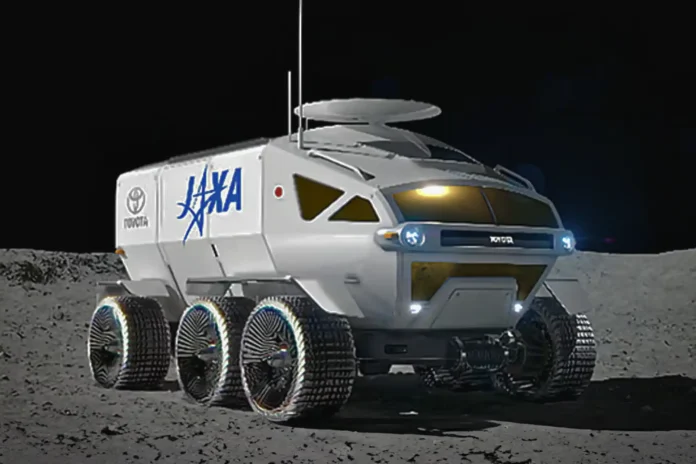As humanity sets sights on a sustained presence on the Moon, the development of lunar vehicles and living quarters is important. Let’s explore two key aspects of lunar adventure: lunar campervan, envisioned as temporary habitats for astronauts, and lunar rovers, designed for mobility across the lunar surface.
Lunar Rover Artemis Mission
The lunar surface is an exciting yet frightening adventure. Brutal temperature variations, harsh dust, and a lack of atmosphere pose challenges for any vehicle. Lunar rovers, therefore, need to be strong, reliable, and capable of navigating these harsh conditions. Several space agencies and private companies are developing lunar rovers with varying functionalities.
Partnership Between NASA & JAXA for the Lunar Cruiser
In this international collaboration, the National Aeronautics and Space Administration (NASA) has partnered with the Japan Aerospace Exploration Agency (JAXA) to create the Lunar Cruiser. This pressurized rover takes inspiration from Toyota’s rugged Land Cruiser vehicles, aiming for exceptional durability and reliability. The partnership between NASA, JAXA, and Toyota signifies a new era in lunar exploration. This collaboration will help strengthen each entity:
Did you know? The unforgiving lunar environment can cause extreme thermal change. In the shade of a crater, temperatures can drop to -173 degrees Celsius (-280 degrees Fahrenheit), while in direct sunlight, they can rise to 127 degrees Celsius (260 degrees Fahrenheit). The Lunar Cruiser must be specially designed to protect astronauts from these extremes.
Read More! Moon Has Entered New Lunar Anthropocene
Toyota Lunar Vehicle
The renowned automaker Toyota brings its extensive experience building terrestrial vehicles. This collaboration provides their knowledge of engineering reliable and efficient machines adapted for the unforgiving lunar environment.
“We are thrilled to be a part of this historic endeavor,” explains Dr. Takeshi Ando, chief engineer at Toyota’s lunar exploration division. “Our expertise in vehicle design and control systems will be crucial in creating a lunar rover that can traverse the Moon’s challenging terrain.”
Features and Capabilities of Lunar Campervan
The Lunar Cruiser is expected to be larger than NASA’s Artemis program’s Lunar Terrain Vehicle (LTV), accommodating four astronauts. It has advanced navigation systems and a longer operational range, allowing for deeper exploration into lunar craters and valleys.
The partnership between NASA, JAXA, and Toyota signifies a new era in lunar exploration, as this collaboration will help strengthen each entity.
Did you know?
- Since the Apollo missions, NASA hasn’t sent astronauts to the lunar surface. The Artemis program aims to change that, with the first crewed lunar landing expected in 2025.
- JAXA’s lunar missions successfully collected samples from asteroids, showcasing their capabilities in deep space exploration.
This combined effort holds promise for developing a powerful and versatile lunar rover that will be instrumental in future lunar missions and pave the way for a sustained human presence on the Moon.
Challenges Faced During Lunar Campervan
While the Lunar Cruiser is a step forward, challenges in its manufacturing remain big. Engineers will need to focus on:
- Designing a lightweight and compact rover for efficient transport to the Moon. Every kilogram counts when launching rockets.
- Ensuring the rover can withstand the harsh lunar environment for extended periods. The unforgiving lunar dust can be particularly abrasive, posing a threat to moving parts.
- Developing sophisticated navigation tools for safe and efficient exploration. Without GPS (which relies on satellites), lunar rovers require alternative navigation techniques.
Despite the challenges, the Lunar Campervan project represents an exciting collaboration for a future of international cooperation in space exploration, like Rolls Royce set to build a city on Moon. The success of this project will not only benefit scientific discovery but also lay the groundwork for lunar tourism and resource extraction ventures in the future.



